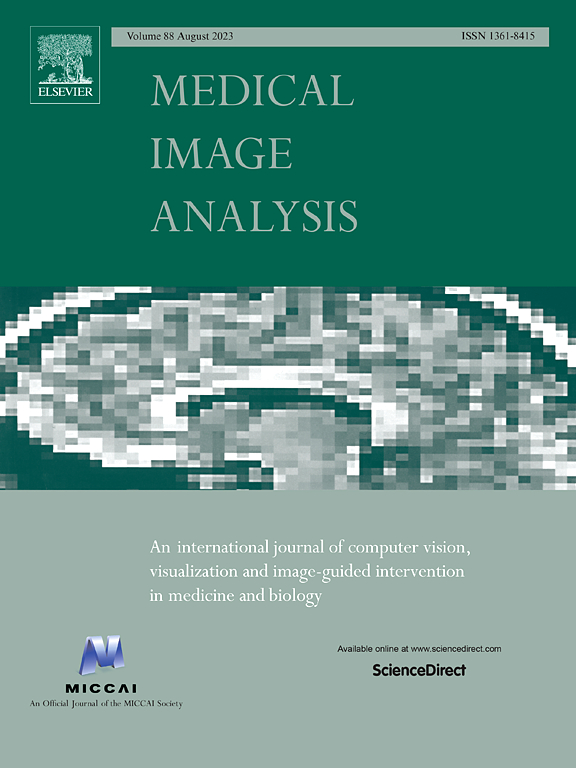IF 10.7
1区 医学
Q1 COMPUTER SCIENCE, ARTIFICIAL INTELLIGENCE
引用次数: 0
摘要
心房颤动(房颤)影响着全球近 5000 万人,是缺血性脑卒中的主要诱因,而脑卒中主要源于左心房附壁(LAA)。目前的临床评分(如 CHA₂DS₂-VASc)虽然有用,但对 Virchow 三联征--血液淤滞、内皮损伤和高凝状态--的促血栓形成机制的了解有限。本研究利用生物物理学计算模型加深了我们对房颤患者血栓形成的了解。利用高时间分辨率的Cine磁共振成像(MRI),开发了一个三维患者特异性建模管道,用于模拟患者左心房内的特异性血流。这种计算流体动力学(CFD)方法与关键凝血蛋白的反应-扩散-对流方程相结合,得出了结合临床和建模数据的创新性风险分层评分。这种方法将血栓形成风险分为低(A)、中(B)和高(C)三个等级。这种方法适用于导管消融治疗前后的九名患者,根据对 Virchow 三联征所有方面的机理分析,得出了新的血栓形成风险评分。目前,基于人口统计学特征和合并疾病的广泛临床风险评分并未考虑血栓形成机制。值得注意的是,一些 CHA₂DS₂-VASc评分为 0(临床风险最低)的患者,一旦考虑到个体病理生理学因素,其风险就会高得多。这种差异凸显了 CHA₂DS₂-VASc评分在提供患者特异性血栓形成风险的详细机制分析方面的局限性。这项工作介绍了一种评估房颤患者血栓形成风险的综合方法,强调了将生物物理模型与临床评分相结合以加强个性化卒中预防策略的价值。本文章由计算机程序翻译,如有差异,请以英文原文为准。

MRI-based modelling of left atrial flow and coagulation to predict risk of thrombogenesis in atrial fibrillation
Atrial fibrillation (AF), impacting nearly 50 million individuals globally, is a major contributor to ischaemic strokes, predominantly originating from the left atrial appendage (LAA). Current clinical scores like CHA₂DS₂-VASc, while useful, provide limited insight into the pro-thrombotic mechanisms of Virchow's triad—blood stasis, endothelial damage, and hypercoagulability. This study leverages biophysical computational modelling to deepen our understanding of thrombogenesis in AF patients. Utilising high temporal resolution Cine magnetic resonance imaging (MRI), a 3D patient-specific modelling pipeline for simulating patient-specific flow in the left atrium was developed. This computational fluid dynamics (CFD) approach was coupled with reaction-diffusion-convection equations for key clotting proteins, leading to an innovative risk stratification score that combines clinical and modelling data. This approach categorises thrombogenic risk into low (A), moderate (B), and high (C) levels. Applied to a cohort of nine patients, pre- and post-catheter ablation therapy, this approach generates novel risk scores of thrombus formation, which are based of mechanistic characterisation of all aspects of the Virchow's triad. Currently, thrombogenesis mechanisms are not factored in widespread clinical risks scores based on demographic characteristics and co-morbidities. Notably, some patients with a CHA₂DS₂-VASc score of 0 (lowest clinical risk) exhibited much higher risks once the individual pathophysiology was accounted for. This discrepancy highlights the limitations of the CHA₂DS₂-VASc score in providing detailed mechanistic insights into patient-specific thrombogenic risk. This work introduces a comprehensive method for assessing thrombus formation risks in AF patients, emphasising the value of integrating biophysical modelling with clinical scores to enhance personalised stroke prevention strategies.
求助全文
通过发布文献求助,成功后即可免费获取论文全文。
去求助
来源期刊

Medical image analysis
工程技术-工程:生物医学
CiteScore
22.10
自引率
6.40%
发文量
309
审稿时长
6.6 months
期刊介绍:
Medical Image Analysis serves as a platform for sharing new research findings in the realm of medical and biological image analysis, with a focus on applications of computer vision, virtual reality, and robotics to biomedical imaging challenges. The journal prioritizes the publication of high-quality, original papers contributing to the fundamental science of processing, analyzing, and utilizing medical and biological images. It welcomes approaches utilizing biomedical image datasets across all spatial scales, from molecular/cellular imaging to tissue/organ imaging.
 求助内容:
求助内容: 应助结果提醒方式:
应助结果提醒方式:


